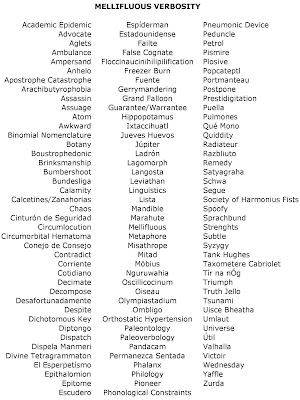
Recently I poked and prodded around the internet, Portland libraries, and even had my mother in California send me a book in the mail to get an example of Delfín Carbonell Bassett’s “Unialphabet.”
Here is why: I think it’s potentially brilliant. It’s a simple gesture that could really change the mindset of students learning language.
October 18, 2008
Here is what it is, in theory: Instead of having and English/Spanish and Spanish/English division in bilingual dictionaries, put them all together in one alphabet, with some sort of key to distinguish which comes from which language. It breaks down the artificial wall, and lets the languages live in the same universe. It may lead to more ‘Spanglish’ writings, but it also stops kids from learning unconsciously that their language of reference can only be thought of one word at a time in the other language, one arrow going to Spanish, one arrow back to English. With the Unialphabet system, all the words are living in bunk beds next to each other, forced to recognize the others’ presence AS WELL AS exponentially increasing the element of serendipity, finding words you weren’t looking for, because now all the words are available all the time as the main words. It also can visually show someone “hey, English has a lot more words in the W section than Spanish, why is that?” pushing a student to think about the fundamentals of language earlier than the day some crazy word enthusiast, such as myself, pushes word facts down their throats without warning.
Here is the problem: The book my mother sent me was a Dictionary of Proverbs, which was on the list of books which used the system on Wikipedia. I know Wikipedia is not the king of information, but by god I thought I could trust it just a little further than I could throw it. Anyway, the red and yellow cover, as you can see, clearly divides it into two sections. One thing it does do is explain English idioms in Spanish, and Spanish idioms in English. Ok, that’s good, but WHY ARE THERE TWO ALPHABETS. UNI! ONE! WTF! I want to love this, I want to write to Erin McKean and tell her for the Dictionary Society of America I want to write a proposal that encourages bilingual dictionaries to be printed unialphabetically for American textbooks, and pocket dictionaries! BUT I DON’T HAVE A REAL EXAMPLE!
In fact, the most true example of a unialphabet that I have access to is my very own “Mellifluous Verbosity,” the list of all the words that make me happy.
So what now? Keep searching for my linguistic path, amuse myself with words, maybe email Mr. Señor Carbonell Bassett again, search for actual images of the Unialphabet in practice. Sigh.
Aspiring paleoverbologist out.
